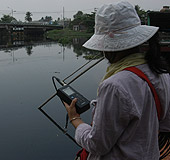Pollution of water: The numbers startled
Domestic wastewater in the city drainage system is now a very serious problem, which can create a high risk of pollution to surface water on the Saigon River.

Each time the test was performed, the pollution indexes increased (Photo: B.Trung)
As the Report on Labor has repeatedly reflected, at the meeting with the Budget and Economic Department of Ho Chi Minh City People's Council, on the morning of July 25, the Department of Natural Resources and Environment (TN-MT) continued to give startling numbers about the situation. water pollution.
Polluted canals increased 95,000 times
In the recent series on environmental pollution, the Labor Newspaper once mentioned the 'dead channels' in the inner city, the survey results of the first 6 months of 2006 of the City Environmental Protection Department further confirmed. : The pollution level of the system of Tau Hu-Ben Nghe canal has increased from 19,000 to 95,000 times compared to the first 6 months of 2005. Particularly, the Tan Hoa - Lo Gom canal is most heavily polluted with the main component of BOD5 in The first 6 months of the year varied in the range of 90 mg / l to 164 mg / l, higher than the permitted standard many times. The value of DO, which lasts from 2001 to the present, shows that this is a dead canal system, no longer self-cleaning. Experts on environmental warnings, domestic wastewater in the city drainage system is a very serious problem, can create a high risk of pollution to surface water on the Saigon River.
Terrifying hospital wastewater
According to a survey by the Department of Environmental Protection, Ho Chi Minh City currently has 109 hospitals and health centers including 83 hospitals, mainly concentrated in districts 1, 3, 5, 10 and Tan Binh. The total volume of wastewater from hospitals and health centers is about 17,276 m3 / day, but most are not well treated. From washing water, hygiene of medical staff to testing water, anatomy . are heavily polluted microorganisms and organic with the content exceeding the standard from 100 to 1,000 times. Specifically, currently only about 3,120 m3 of wastewater / day is treated to meet environmental standards and only 78/109 hospitals, district health centers have wastewater treatment systems.
Mr. Nguyen Van Chien, Deputy Director of the Department of Natural Resources and Environment, said there are two reasons leading to the increase in medical wastewater and ineffective treatment. It is the operation and maintenance for the wastewater treatment system that has not been properly invested, many places are seriously degraded and must be stopped. In addition, due to increasing demand for medical examination and treatment, many places have increased their capacity without investing in synchronous wastewater treatment systems.
Talking about the situation of waste water treatment in health facilities, Mr. Huynh Cong Hung, Deputy Head of the Economic and Budget Department of Ho Chi Minh City People's Committee, expressed concern. He said: 'During a check-up of medical facilities, the team discovered a medical station in a district in the city that left 3 cars with septic tanks ' residing 'right on the campus'!
Groundwater, surface water are all SOS!
According to water level monitoring documents from 2000 to the present, the water level in the aquifers is getting lower and lower, this is the risk of depletion of aquifers. The lowering water level leads to saline intrusion and pollutants into the aquifer, the risk of land subsidence due to the dryness of the aquifer. Groundwater at the monitoring stations of Truong Tho and Linh Trung is contaminated with iron in excess of the permitted standards and higher than the first 6 months of 2005. More seriously, shallow groundwater level at Binh Hung station is heavily contaminated with alum.
Along with the same fate, the state of surface water in the Saigon and Dong Nai rivers is also being polluted more and more seriously. Results of colifoorm analysis in the first 6 months at the monitoring station on Dong Nai river increased 50 times compared to the previous year. According to environmental authorities, at Phu Cuong, Binh Phuoc and Phu An stations (Saigon River), organic, oil and microorganisms are also contaminated.
- China faces serious water pollution
- Interestingly, the numbers in mathematics are unknown
- Clean water and numbers to speak
- Harm of polluted water
- Startled garbage technology
- Alarm of water pollution in HCMC
- Startled, Vietnam is affected by mercury pollution from China?
- Pi numbers and art
- The strange thing hidden behind pi
- China's coastal water is seriously polluted
- Lake water turns into 'jelly' because of pollution
- Review the 8 most important numbers in mathematics
 Is the magnetic North Pole shift dangerous to humanity?
Is the magnetic North Pole shift dangerous to humanity? Washington legalizes the recycling of human bodies into fertilizer
Washington legalizes the recycling of human bodies into fertilizer Lightning stone - the mysterious guest
Lightning stone - the mysterious guest Stunned by the mysterious sunset, strange appearance
Stunned by the mysterious sunset, strange appearance